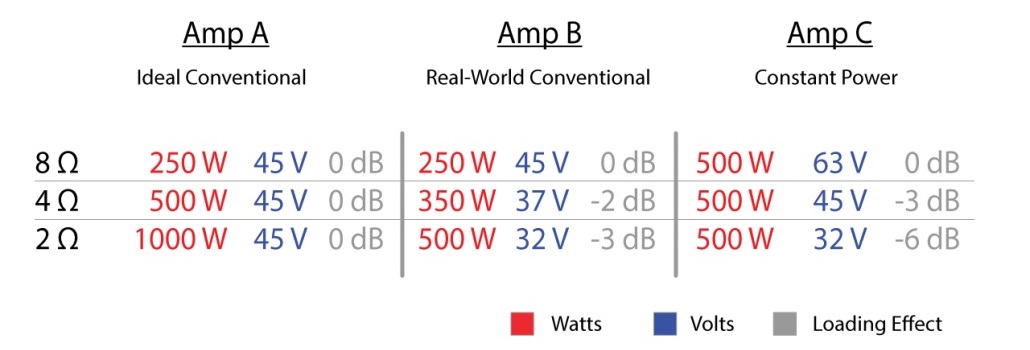There are several competing philosophies among audio power amplifier designers as to how an amplifier should behave under load. They can be constant voltage, constant power, or some hybrid between the two.
A “constant voltage” amplifier maintains its output voltage independent of load impedance. This requires that it produce 2x the current each time the load impedance is halved. A real-world amplifier will have a limit as to how low an impedance it can drive, with 4 ohms being common.
Amplifiers can be designed for “constant power” operation, where the output voltage is designed to drop predictably under load. For example, an amplifier may be rated at “100 watts into any load impedance.” The amplifier keeps working, even if loaded to 1 ohm or less. It basically turns itself down as the current draw increases, never letting the power exceed the maximum that the amplifier is designed for.
These and other design philosophies can be compared using a “parade route” scenario.
How It Works
Consider a parade route, where four loudspeakers on stands are needed to cover a long seating area. Since only four are needed, the sound system designer is tempted to use a low-impedance distribution approach where 8-ohm loudspeakers are daisy-chained onto a single amplifier (Figure 1).

There are three amplifiers being considered for the project. They are rated as described in Figure 2. The gray text shows the Loading Effect as described in the Common Amplifier Format Reference. It provides the voltage drop caused by the increased load (lower ohms), relative to a reference condition, which in this case is the 8-ohm load.

“Ideal” conventional amplifier. As the techs deploy the system, some program material is fed to the amplifier. The connection is made to Spk A (Speaker A) and the amplifier input sensitivity is adjusted to produce the target listening level. Spk B is connected to the parallel jack of Spk A and starts playing. Since the amplifier’s output voltage is unchanged by the added load, the SPL from Spk A is not affected, and Spk B plays at the same level. The process is repeated for Spk C and Spk D, with the SPL from Spk A (and Spk B) unaffected by the presence of C and D.
This amplifier maintains its output voltage and doubles its current (and audio power) for each halving of the load impedance. It’s rated to maintain this behavior down to 2 ohms. Note that the 2-ohm load will require very heavy cable, but that’s a different topic.





















